“Rather than initiating the death of painting, as was expected, photography and other media of mechanical reproduction have been like a vampire’s kiss that makes painting immortal. Painting is enthralled before the cold eye of mechanical reproduction and can stare back in the same way.”
—David Reed, 2006
In a sense, painting has always existed in relation to technology, when the term is understood in its broad definition as the practical application of specialized knowledge: the brush, the compass, the camera obscura, photography, or the inkjet printer. However, it is only now that, along the lines of physical presence and a shared role as content-delivery systems, painting is so closely affiliated—morphologically, aesthetically, and conceptually—with the (digital) technologies it engages with. Today both artist and viewer share the experience of digital technologies as familiar, available, and omnipresent. An artist today is automatically involved with ways of looking, thinking, and acting that are conditioned by technology, even if their work is not ostensibly dealing directly with technological concerns. The current conversation between art and technology is thus not necessarily a result of artists appropriating arcane or specialized knowledge, as when in the 1960s they avidly followed, and made use of, the latest innovations published in Scientific American.
When artist Michael Staniak says, “the screen is as normal a part of my day-to-day life as eating,” he is not only speaking about the conditions that inform his paintings, but also about a nearly universal situation among a certain class in the developed world—an incredibly profound one that has opened up painting, especially in its abstract guise, to an entirely new audience that lacks, indeed does not need, an education or background in the critical and formal examination of art and its history.[i] This has led to fundamental changes in the way a painting looks, communicates, and circulates, which has in turn attracted a new, younger generation of artists who approach the medium differently than their historical antecedents, deploying it to varied ends. In a quiet but incredibly profound way they have rebuilt painting from the ground up.

Michael Staniak, Untitled (Holographic) 2013
These artists are using the medium as a frame, tool, or focal point by which to address a number of pressing issues related to, among other things, labor, technology, the body, and perceptual experience—rather than, as is often dismissively and reductively suggested, approaching it as a reflexive, medium-specific extension of modernism. This is a direct result of the new roles that painting has taken on in a digital age.
Surface
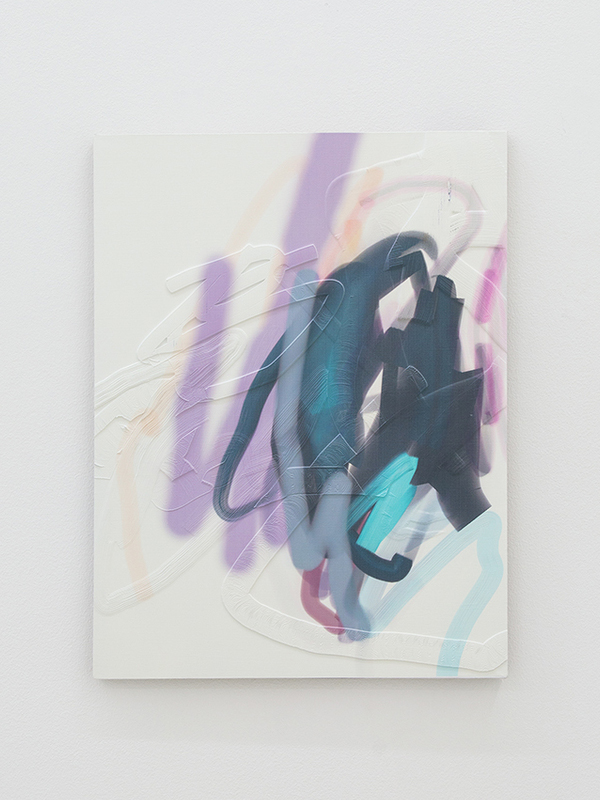
Michael Manning, Nine Pound Hammer (2015). 45x60cm 3D Print on linen.
In order to understand how painterly work operates today we must first address the question of what, at a material level, it comprises. Today a two-dimensional (or in some cases a sufficiently shallow projection) hung parallel to a wall is enough to suggest a painterly conversation, which may take place through any number of materials.
We are thus not tackling the related question of those image-based works, called digital paintings by some, that are made with—and for consumption on—computers.[ii] These works obviate many of the material concerns traditional to painting, since it cannot even be said—as it might for an artist like Ken Okiishi, say, who uses the screen as a support in a literal fashion—that the computer is their support, as they morph into varied digital contexts. Some require an internet connection to be experienced, others only function on social media apps viewed on smartphones, while still others stand alone on any screen. These must be understood as contemporary examples of the dispersal of the painterly as an effect. These works appropriate the term “painting” because they are image-based, but not photographic or filmic, and are placed in an art, or at least non-traditional, context, through placement on particular blogs, dedicated websites, etc. Some of them might for these reasons also equally be called “digital drawings,” as they indeed sometimes are. Their connection to specific painterly effects ranges greatly, though again they share in common their non-specificity, which is a practical necessity given the uncontrollable nature of the way that each individual will encounter a given work.
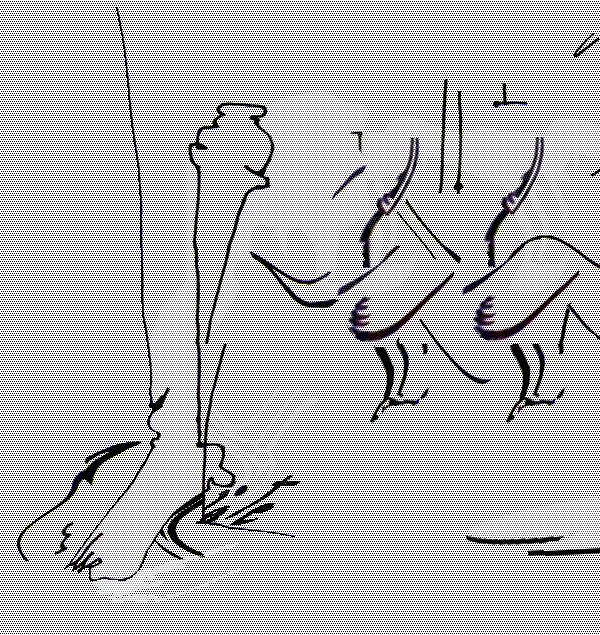
Laura Brothers, alfredo frenzy (Sept 10, 2015). Detail area of 940x700 pixel digital image.
For the sake of space, and also the different set of concerns suggested, I will focus almost entirely on those physical works that we might call paintings. Though it should be noted that several artists today move back and forth between these two realms in interesting and productive ways, such as Parker Ito or Michael Manning, whose creative training was in the technical skill of animation, rather than the craft-based one of painting. Manning’s earliest works were made on and for the computer, but in response to both exhibition and financial concerns, he started to print his digital paintings on canvas. With time he has increasingly embraced the materialist aspect of painting, adding complexity to a practice that continues to involve purely digital projects. First this meant adding a layer of clear acrylic gel over the printed canvas, to which he used combs and brushes to add staged painterly effects. Recently, this practice has evolved to having the work 3-D printed, using technology designed to read and simulate actual painting marks. This leads to curious effects when the machine is given entirely digital data, layering marks in odd ways and inverting positive and negative space.
We have thus moved far beyond Clement Greenberg’s famous maxim from 1962 that “a stretched or tacked-up canvas already exists as a picture – though not necessarily as a successful one.”[iii] In essence what holds true today is the notion of painting as a frame, within which any number of materials might enter, a concept that is not new, and which is certainly predicated on any number of precedents, from Pablo Picasso to Kurt Schwitters to Robert Rauschenberg to Daniel Buren. However, how exactly in our present moment painting functions as a frame, and in doing so enables an artist the effortless and unquestioned ability to use the space of the wall for the accumulation and presentation of materials and objects, is one of the primary questions we must ask. I would contend that the answer lies with recent technological development. In 1971 art historian Leo Steinberg wrote influentially, with regards to Rauschenberg’s work, of the emergence in art of the 1950s of the logic of the flatbed picture plane, a shift in his eyes from a focus on nature to one on culture:
The flatbed picture plane makes its symbolic allusion to hard surfaces such as tabletops, studio floors, charts, bulletin boards—any receptor surface on which objects are scattered, on which data is entered, on which information may be received, printed, impressed—whether coherently or in confusion. The pictures of the last fifteen to twenty years insist on a radically new orientation, in which the painted surface is no longer the analogue of a visual experience of nature but of operational processes.[iv]
But of course the space in which these operations occurred was still that of stretched canvas or panel, and the logic was an analog one—of labor and activity and knowledge. Similarly it implies a certain fixity, the end result of the process in question, which has been frozen for display, as Steinberg implies when he writes of artists like Rauschenberg and Dubuffet, “we can still hang their pictures—just as we tack up maps and architectural plans, or nail a horseshoe to the wall for good luck.”[v] However, if we follow Steinberg that these precedents had shifted the emphasis from nature to culture, then it also follows that we should attend to the evolution of culture since the late 1960s and early ’70s, when Steinberg formulated this idea.
This suggests that we consider that the proliferation in the past decade or so of laptops, tablets, smartphones, and flatscreen televisions—all of which are interfaces housed in slender casings—has done many things to the presentation of images, and consequently to our perception and consumption of them, while also activating a whole new array of materials and means of display.
That this makes digital devices morphologically very close in form as well as function to a painting is succinctly demonstrated in a series of works by Simon Denny, "Multimedia Double Canvases" (2009), in which the artist commercially printed the home screens of various televisions onto cheap pre-stretched canvases available for almost nothing at any art supply or craft store. In these it is most remarkable exactly how absent a painting discourse is from our engagement with these cheap inkjet printed canvases. Tracking the evolution of television size over the span of about fifteen years, for each television Denny placed two identical canvases parallel to one another and joined them with steel poles, miming the dimensions of the television in question. He does this on down to the present, with the space between the panels getting smaller and smaller to the point where a single canvas will do. The canvas and the flatscreen have become quite literally one and the same. In this way we have an answer of sorts to Hal Foster’s provocative query, asking if it is possible to “seriously engage issues of a technoscientific, postindustrial society in a medium, like painting, based in preindustrial craft?”[vi] The answer is that just as a wheel can equally serve a car as it did a horse drawn carriage, so does our continued reliance on the shallow, wall-mounted display prove that painting has something to say to our present moment. Further, it asserts the capability for painting to once again reconnect with the material conditions of our historical present, from which it was structurally barred for a period.
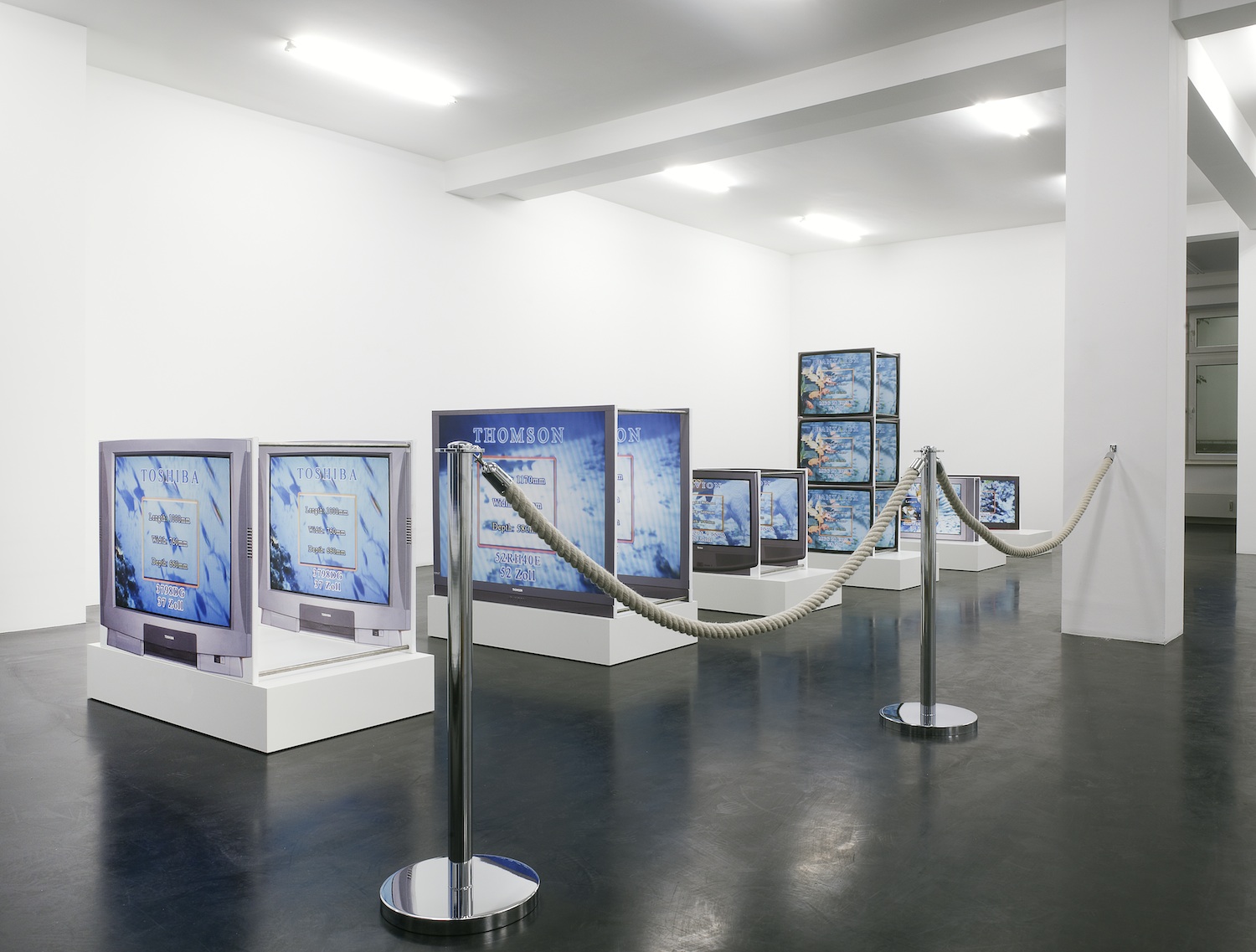
Simon Denny, Simon Denny, "Multimedia Double Canvases" (2009). Courtesy Galerie Buchholz, Berlin/Cologne/New York.
It is not only that artists are exploring the similarities between screen and canvas, but that canvas has entered the everyday vernacular of trade show advertisements, DIY Kinko’s projects, and store window displays. These are of far more interest to an artist like Denny than the history of painting, and no doubt he finds that there is no need for him to deal with that history. The question with Denny’s work is not so much how does his use of canvas as a support complicate his investigation of the systems—financial, social, and bureaucratic—surrounding technology, but rather what critical distance it might enable, underlining his interventions as, to some degree, aesthetic and drawing attention to his goal of exploring the ramifications of technology.
There is a lot that can be done with a flat, bounded surface, even if each artist’s surface of choice might vary, materially, along a continuum that extends from the time-worn painterly convention of canvas through to industrially-sourced Dibond aluminum panels. Take, for example, Ken Okiishi, who uses flatscreens as a support for painted marks that are, in a way, equally reminiscent of the swipe marks our greasy fingers leave on touchscreens, as they are of the gesturalism of Abstract Expressionists like Willem De Kooning and Joan Mitchell. Working on this series since 2013, in the beginning Okiishi used recorded videos, often derived from old VHS tapes. This can be seen in gesture/title (2013), which he showed at the 2014 Whitney Biennial, where five painted monitors ran the same infomercial starting at different points. Here the image is only fragmentarily discernable through the obscuring aggregation of paint. When looking at them we find that at some points the painted marks seem to merge with the image, and indeed Okiishi painted the screens with the videos playing so that he could respond to formal aspects of the infomercial’s unfolding narrative, and at the end of the process he often slightly edits the footage to make its compositional continuity with the painted marks even tighter.
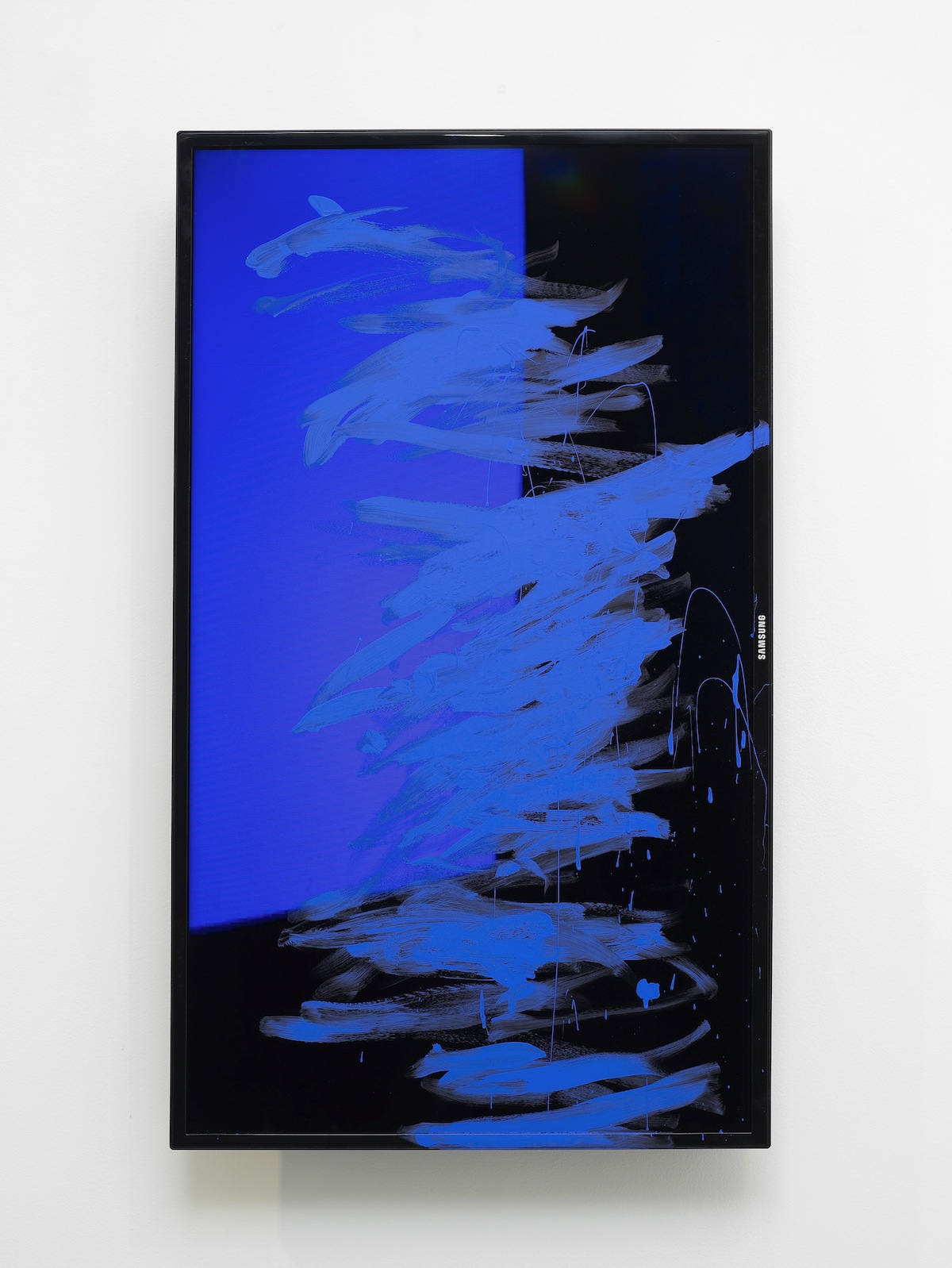
Ken Okiishi, gesture/data (2013). Chroma blue video paint on MD40B 40” Large Format Display LED, BARCO CRT blue screen videoed by HD camera transferred to .mov transferred to .mp4. 492.5 x 54.1 x 9.4 cm.
Recent work by Aaron Bobrow and Mary Ramsden also references the gestures inherent in the action of swiping and other tactile maneuvers of digital devices. That they do so with paint on panel suggests an analogy with the familiar path made by the brush as it traverses a receptive surface. Staniak has also engaged with this, noting that the “element of ‘touch’ is synonymous with digital media and also primitive image making. It takes the image making process back to the most carnal implementations of pigment on cave walls, where muddy mixtures were applied very physically by hand.”[vii] Appropriately, in his latest body of work, collectively titled Permanent Display, Staniak downloads stock images of stone surfaces from the internet, which he then collages together and on top of which he draws rudimentary pictographs with his finger, rather than a mouse or stylus.
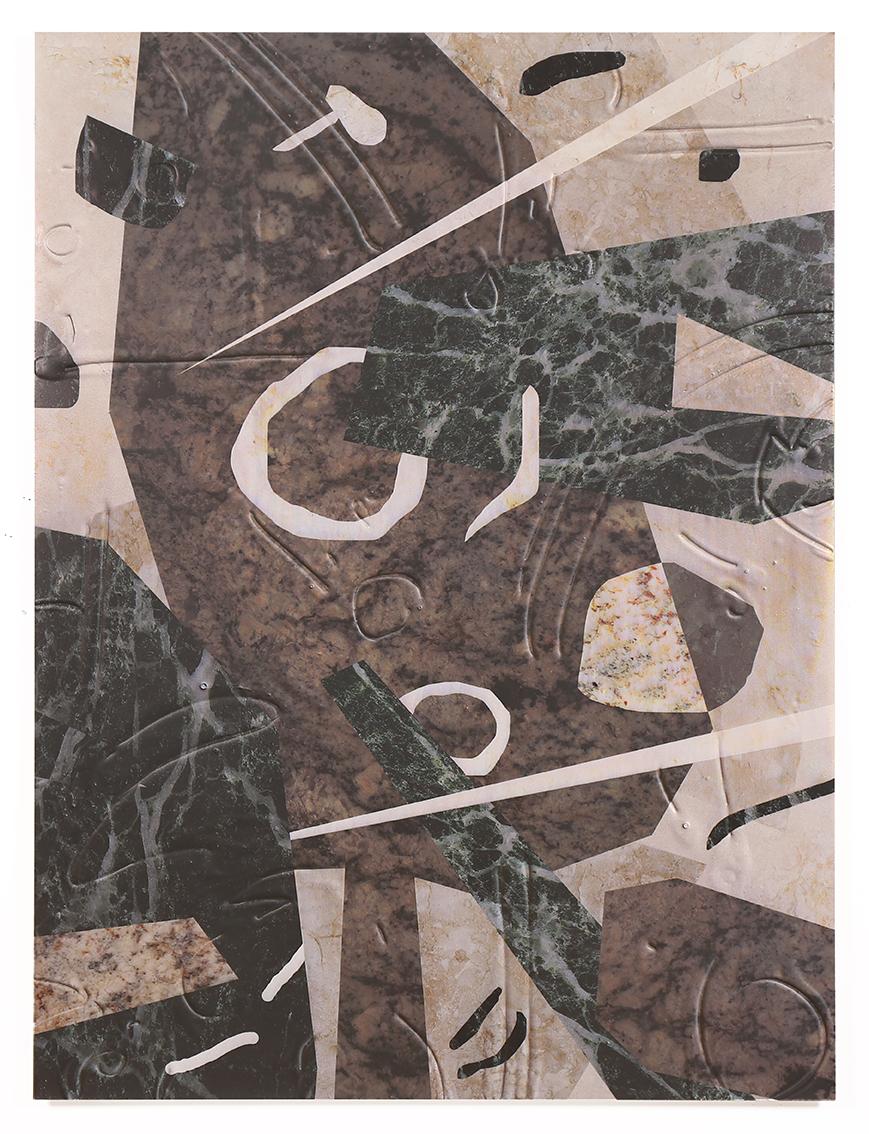
Michael Staniak, BMP_145
This approach appeared as early as the 1980s in the work of David Reed, who must be acknowledged as a predecessor of this way of working. Reed’s career has been animated by, among other things, a concern with how the gesture can be motivated in different moments. This began in the ’70s with his use of the body as measure—making paintings predicated on the maximum length and density his arm could make with a brush loaded with paint. By the ’80s Reed was experimenting with gestures mediated by their interpretation through computer imaging. He found that the computer’s interpretation of the gesture was somehow more convincingly “organic” than the original hand-made gesture he made to be interpreted. His work since has been engaged with juxtaposing different kinds of gestures, from the hand-made to the digitally altered to the stenciled, in an exploration of how meaning accrues through this supposedly most immediate and biographical mark.
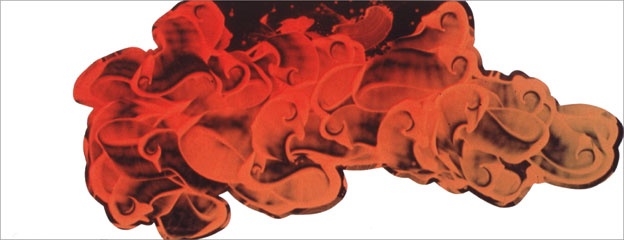
David Reed, #337 (1994). Oil and alkyd on linen. 30 x 130 inches. Collection Orange County Museum of Art.
With the close proximity of painting today to digital devices, there is no longer so much a tension between what sits squarely in the realm of painting, and what resides in its “expanded field,” as much as a new meta-logic, both artistic and extra-artistic, of surfaces mounted parallel to the wall, of which painting is just one element alongside digital displays, commercially printed canvases, etc. For convenience and to provide an established, familiar frame of reference, we should continue to refer to wall-based works concerned with questions of surface as “paintings,” and even potentially explore the semantic ramifications of admitting these typically non-aesthetic objects that share painting’s expanded field, especially since this brand of art derives its meanings and possibilities—perceptual, material, and conceptual—as much from the conventions of digital technology as from the history of painting.
If hanging a shallow object parallel to a wall is now enough to suggest to a viewer, even if unconsciously, both the conventional manifestation of a painting and that of an array of digital devices, then this means that painting as a medium doesn’t exist in the same form it held in the middle of the twentieth century—a contention that, frustratingly and mind-bogglingly, many continue to make as if this received understanding is the only possible way to understand a painting. As art historian Richard Shiff has recently noted, this is far more a failure of the tools of contemporary criticism than evidence of anemia in the field of painterly production; and, as he demonstrates, this incapacity to deal seriously with painting has dogged criticism since the 1960s at least.[viii] The medium has, in fact, been taken apart, dissected, dispersed, and hybridized for decades. This suggests that painting does not have a single, essential status, but rather a multiple and constantly changing one, due to pressures both internal and external to it, and to art more broadly.
In a sense it may be more accurate today to understand artist Robert Mangold’s vision of a “flat art” as having come to pass, and into which what we understand to be painting has been subsumed, than seeing the terms established historically within the medium of painting as having been expanded. Mangold wrote presciently in 1967: “Flat art, or art with only one view, includes paintings and flat surface works of any type…. Flat art is all surface, the edges are simply edges of a surface. The thickness is the thickness of the material chosen to work upon, and in some cases the additional thickness of the support needed.”[ix]
From our present vantage, it is perhaps even better than “flat,” to refer to such works as being about “surface.” This retains the sense of all-at-once, direct experience, and the single viewpoint suggested by Mangold, but prevents us from getting caught up in the outmoded 1960s discourse around flatness, since today many artists find that they can introduce various textures and materials into the picture plane without fundamentally disturbing our experience of that as a singular, discrete surface.[x] This is because all things are fundamentally understood as images, rather than as objects. It is that experience, perhaps more than any other, which today we associate with what we call “painting.”
The reason why Mangold’s vision could not have been realized in the mid-to-late 1960s—and why his “flat art” manuscript languished in a drawer for decades—was because, until recently, a work on canvas spoke only to an art context, a quality which rendered it excessively passive for the likes of Donald Judd, who preferred the use of “actual” materials because of the worldliness they suggested to the viewer: “Materials vary greatly and are simply materials—formica, aluminum, cold-rolled steel, plexiglas, red and common brass, and so forth. They are specific. If they are used directly, they are more specific. Also, they are usually aggressive.”[xi]
Artists like Judd and Robert Morris found that alluding to the world of real objects heightened the work’s phenomenological impact because it aligned the presence of the work with the presence of things. Greenberg highlighted this in his 1967 essay “The Recentness of Sculpture” when he wrote that, “presence can be conferred by size or by the look of non-art.” At that point in time, Greenberg notes, the brief opening of painting out to the world that was achieved by artists such as Pollock and the other Abstract Expressionists, who actively incorporated raw canvas into their work, was nullified once it became theoretically possible to display even a blank canvas successfully as a painting. This brought canvas into the world of art, no matter what guise it took on, away from that of things—for example the sailcloth that it started as. As such, it had to wait for another revolution in imaging technology—namely, the one we are presently experiencing—to bring painting back into a materialist dialogue with things in the world.
Today the time has long since passed when painting referred only to art. True, or “pure “self-referentiality to the medium is impossible, just as it has always been for sculpture, which always had to navigate our familiarity with bodies and objects in the world in articulating its particular status as a form of art (if we accept a Kantian definition of art as determined by the absence of functionality). Now paint on canvas finds itself bounded by a field of possibility as equally conditioned by the imagistic, material, display, circulation, and reception situation as that which is historically the province of painting. Even more significantly, a printed Dibond panel intended to be hung parallel to the wall finds itself in the same position. Because the dialogue it is entering into is hybrid, in a way that is ultimately indistinguishable, between painting and digital devices there is not much functional difference between paint brushed onto canvas, and ink printed onto panel. Now, despite the furious debate around the future of painting, and its relation to other mediums that was waged beginning in the 1960s, there was not (and still has not been) much emphasis placed on the preciousness of painting’s favored and traditional or conventional materials.
One could say that Robert Ryman was perhaps the first artist to systematically explore this expanded situation, which is one of display more than of painting. Painting was Ryman’s tool of choice to explore these conditions, and he worked on stretched and unstretched canvas, as well as on a variety of other materials from wood panel, to aluminum, to paper. Ryman pursued, among other things, an investigation of both the expressive potential of these materials, and the possibilities for their display. The generation of artists active today are seeking out the best support for each of their aesthetic goals, and also want to establish integrity between materials and the ends to which they are deployed. Many would likely agree with Mangold’s 1966 claim that “canvas is flimsy, brittle, lacks dimension; it refers only to art. Plywood can be hit with a hammer. I like that fact. It's very important that the surface be a substantial thing.” One can imagine that this is part of what animates the work of artists like Zak Kitnick and Nikolas Gambaroff, who do not so much wish to enter into an explicit dialogue with painting, as find their way onto the wall without being too weighed down by the history of either painting or sculpture. Steel, a material with a relatively short history of use in a fine art context, and one with a familiarity in an industrial one, accomplishes this handily, as it did for Donald Judd years before.
But it must also be acknowledged that many other artists have found that canvas can be as factual and workable a material as plywood, stripped of much of its historical specificity, and thus able to return to its origins in practical uses, such as for sailcloth. This is for example what David Ostrowski’s paintings succeed at suggesting, insofar as it is their emphatic use of a limited painterly vocabulary of materials: stretched canvas, frames, slight applications of pigment. That they are legible as paintings at all is a testament to the power of these materials. Still others have merged the organicism and history of woven cotton with the pragmatic familiarity of the 8-by-4-foot dimension common to industrial materials. For example, in different ways both Aaron Garber-Maikovska and Calvin Marcus discovered this joining as the perfect support for a reexamination of the potential for the expressive mark: gestural in the case of Garber-Maikovska, surrealist automatist in Marcus’s.
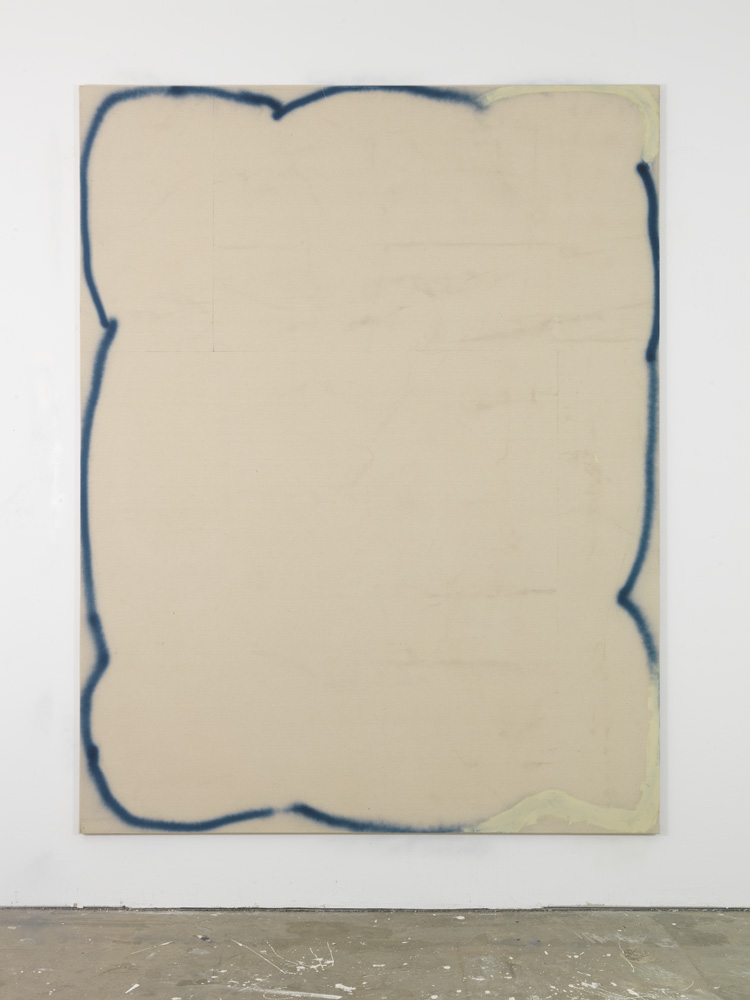
David Ostrowski, F (A thing is a thing in a whole which it’s not) (2012). Oil and lacquer on canvas, wood. 86 3/4 x 67 in. (220 x 170 cm).
This is not to say that artists are now returning to the notion of a painting as autonomous from the world in which it necessarily exists. Far from it. Rather, they are accepting the curious objecthood that a wall-mounted thing possesses today and are exploring this new specificity alongside a painting’s inevitable interaction with things outside of itself—from the site of display and other traditional concerns of Conceptual art and Institutional Critique to the networks in which a painting travels: digital, financial, and otherwise. For example, Jesse Stecklow has been involved, in a way that, like Denny, effortlessly traverses the languages of both painting and sculpture without relying too much on the specific conventions of either, with invisible but omnipresent systems of ecological data collection. These range from the primitive system of fly tape to the more sophisticated (and implicitly painterly) wall-mounted steel boxes that record the microscopic content of the air in the spaces in which they are installed. Stecklow continues to periodically manually retrieve information from these sites, pointedly refusing to rely on the abstracted digital relay of this data. This body of work is thus engaged with both physical and networked elements of circulation as it involves aspects of the surveillance of the spaces we navigate everyday, and in the process suggests numerous larger political issues, both benign and sinister.
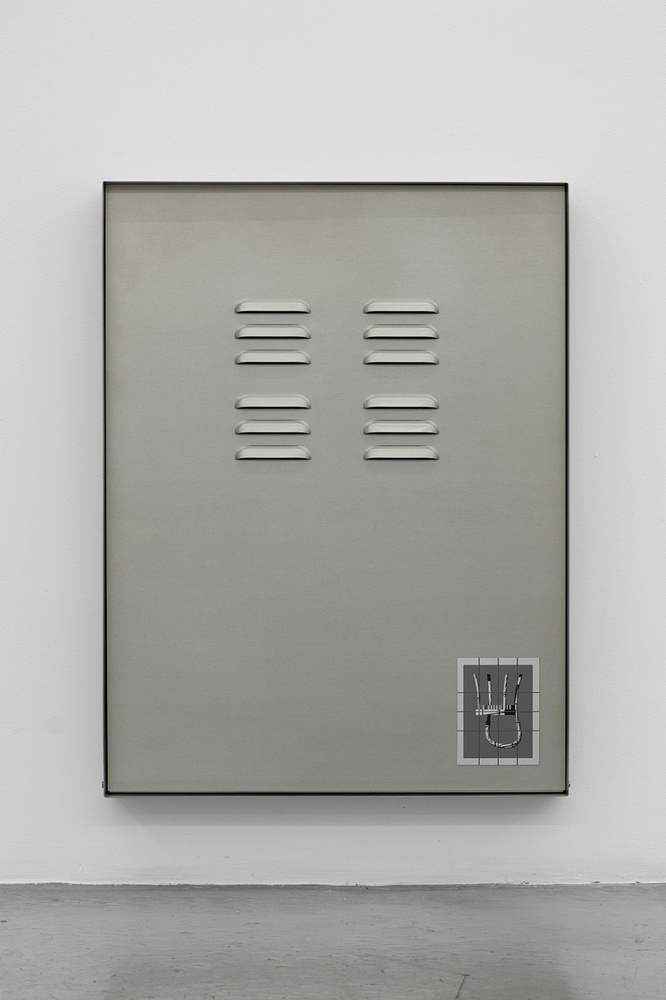
Jesse Stecklow, Untitled (Air Vent) (2014). Steel, powder-coated aluminum, UV print, hardware, carbograph 5 Air sampler. 24 x 18 x 2-1/4 inches.
All objects exist in this dual way today, as both discrete and networked—present and dispersed at the same time—and it is in this dual way that the most astute artists working today recognize any art object must be addressed. This is to say that, while any given painting may be specific, the content that it delivers cannot be imagined as stable and singular, but as reaching any number of eyes and contexts, just as is true of the information that circulates through digital networks and arrives on innumerable screens. This is also quite literally true when we consider the role of reproductions of paintings, where many more people will view a given work in the glow of an iPhone screen, than will see it in person.
Image
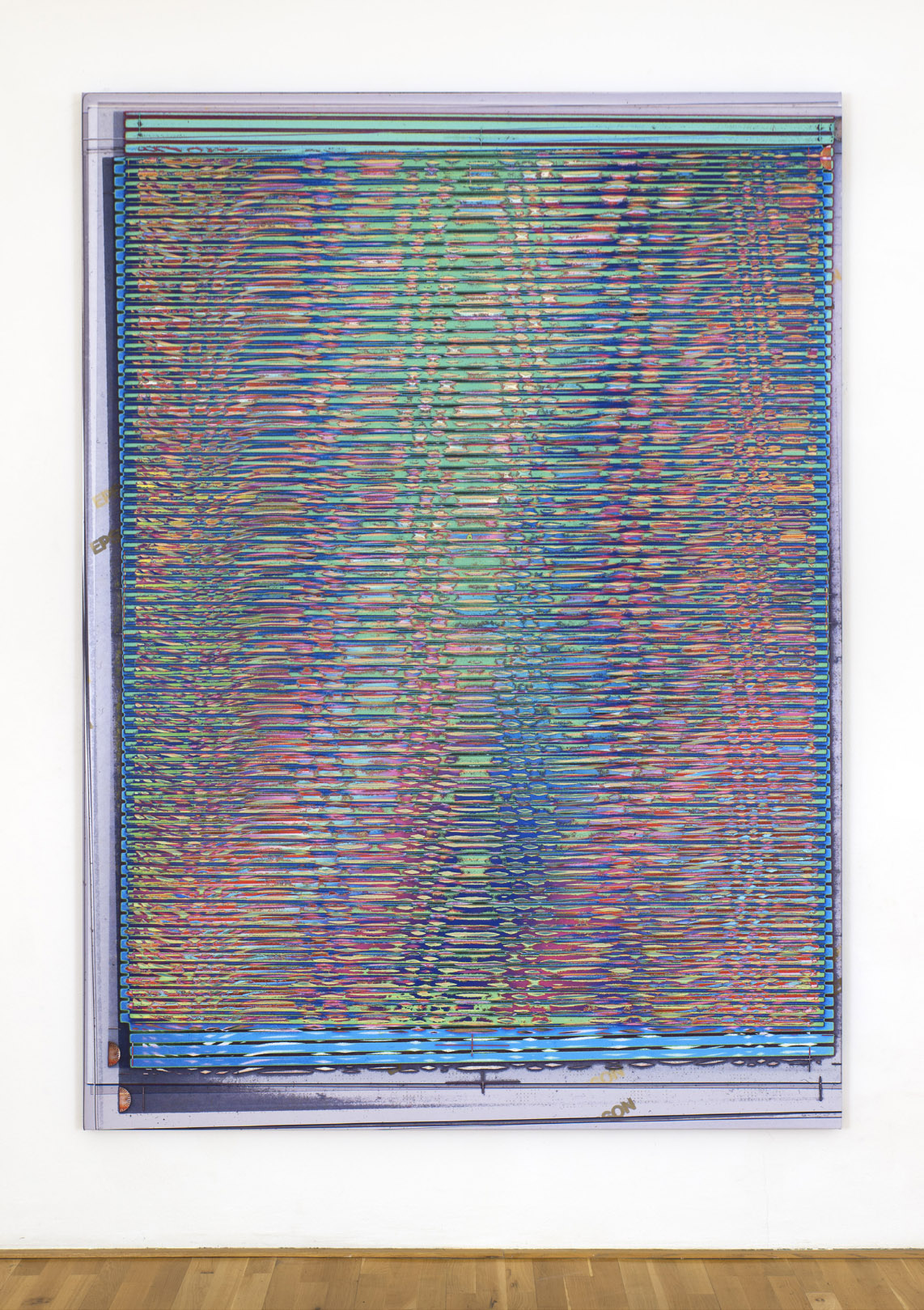
Travess Smalley, Vector Weave - Oct 12 2014 Action 5 applied to Oct 1 Photocopy Scan 05, 2015, 96 x 70 in (2014).
In a sense, today flat works benefit from the ability to arrest an image and place it in state of stasis that is increasingly foreign to other modes by which images are beheld. This is contra to the photograph, which, since the advent of film has been imaginable as a still in a sequence of events, or at least as temporally based, since it is necessarily a record of something—even if that something is entirely the fantasy of the photographer, manipulated either in the darkroom or in Photoshop—and thus mutable. This stasis such flat works inherit from painting allows for traditional modes of contemplation, meditation, and appreciation, which are still necessary for a critical appreciation of the material we are presented with. My choice of the word “arrest” is purposeful. I want to suggest the violence by which circulation is interrupted and situations of fixity are introduced when the image gets caught in a painting frame.
Painting is, as I have been arguing, equally beholden to the conventions of digital technology as it is to those of art history, and as such, we bring to bear our expectations of interactivity and malleability, which have been cultivated by the former. Most often these play out in how we perceive the spatial terms of the work, which we do not so much penetrate optically as manipulate in a new form of opticality that is sutured to a virtual form of tactility, which is to say the new kinds of motor skills that are cultivated by the touchscreen—actions like clicking, swiping, pinching, tapping, and pressing.
The issue for painting today does not have to do with pictorial space, but, rather, is engaged with the question of object versus image. Regarding work that actively engages imagery (which is a term I prefer to “representation”), this introduces the question of scale as central, and by extension that of scalability. Any image placed before us, if it is vector (i.e., mathematically generated) rather than raster (i.e., pixel-based) in nature, can be scrolled into and out of infinitely. This very access to and capability for manipulation that the image holds leads to this draining of significatory weight from distance and relative scale.[xii] For example, in recent work shown in Berlin at Croy Nielsen by Sebastian Black the painting’s literal dimensions function like a screen of sorts, as we find a single painted composition rotated across four canvases. In these works the canvas does not change orientation, but rather just the painted image that, in a confirmation of our suppositions about the screenic paradigm, is able to exist even when truncated and not fully filling its rectilinear container. Here the canvas functions along the lines, structurally, of a screen. The integrity of the painting as image and object simultaneously is asserted without having to rely on the old model of identifying the two with one another literally, as was the case of deductive structure in Frank Stella’s stripe paintings, for example, where the painted pattern reinforced the work’s literal limits and vice-versa. Today any rectilinear support can assert identity with any painted image as long as this screenic logic is obeyed.
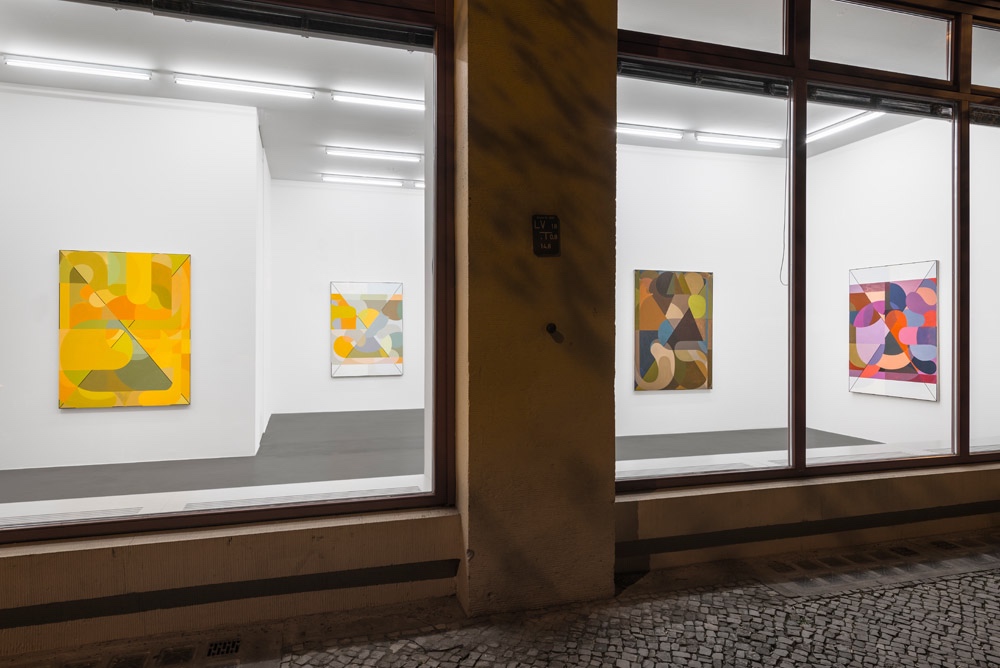
Sebastian Black, "Completed Paintings." Installation view, Croy Nielsen, Berlin, 2016.
These things combine to create a new pictorial vocabulary for artists who import digital conventions like drop shadows, the harsh and arbitrary lines of cut-and-paste actions, and digital color schemes like gradients into painting. All this is linked to a larger flattening and collapsing of space, which can be seen in the various parts of paintings by artists like Laura Owens, Trudy Benson, Michael Williams, Jamian Juliano-Villani, or Josh Reames, where completely different spatial relationships can hold from one-square inch of the canvas to the next, creating complicated, even dizzying spatial twists and inversions in the work of the original master of this style, Owens, and more relatively banal importation of these devices to the ordered, conservative canvases of Reames, who seems to create rebuses consisting of random assemblages of contemporary iconography. I am somewhat skeptical about the ability for these kinds of images to hold our interest in the long run, and not quickly seem outdated and esoteric.
For an artist like Travess Smalley, the ability to physically move in and out and around an image is the main reason to bring works created on the computer screen into physical existence, and why they then might be a certain size and, indeed, stretched, thus gaining dimension, and presented on the wall. The image even wraps around the sides of the canvas, emphasizing this dimensionality. This is because this form of presentation allows the viewer to move in and out from the image in a physical way, rather than the fully abstract means by which one manipulates the scale of an image in the fixed frame provided by a screen. In a certain way, here again, we find the stasis and focus of painting to engage productively with the interactivity we expect from the screen, providing the viewer with a different experience of scale.
Avery K. Singer, who uses digital technology via the commercially available architecture and design modeling program Google SketchUp to produce her paintings, brings traditional perspectival painterly tropes into conversation with digital means of reading space and content, these being conditioned primarily by our experience of multiple perceptual regimes coexisting in the tessellated space of the desktop and other screens. Because Singer was trained in sculpture rather than architecture, design, or even painting, this can be understood as operating in a way similar to how graph paper functioned for the ’60s generation of minimal and conceptual artists. The likes of Jo Baer, Donald Judd, Mel Bochner, and Larry Poons were not familiar with the professional uses of graph paper as a way to more directly envision objects and structures, by circumventing established (and deceptive) conventions of perspectival representation. This same curiously airless, imaginary, yet somehow more directly “accurate” representational logic has been translated into programs like SketchUp. Singer is able to introduce, as she put it in an interview with Lauren Cornell, “representations of idealized sculptures and monuments, with figures and still lifes” into “the realm of unrealized buildings.”[xiii] That being the conventional end-point of designs made in SketchUp. That she then projects the images she creates digitally onto canvas an executes them in grisaille (and more recently color) using a spraygun also connects Singer’s practice to Vermeer’s use of the camera obscura to realize exacting placements of figures and objects in ways that are impossible to realize with just the five senses. It is in this way that we can understand the camera obscura to introduce a photographic logic (aka an extra or hyper sensory, because “all-seeing,” apparatus) into painting, which Singer’s work shows continues to evolve.
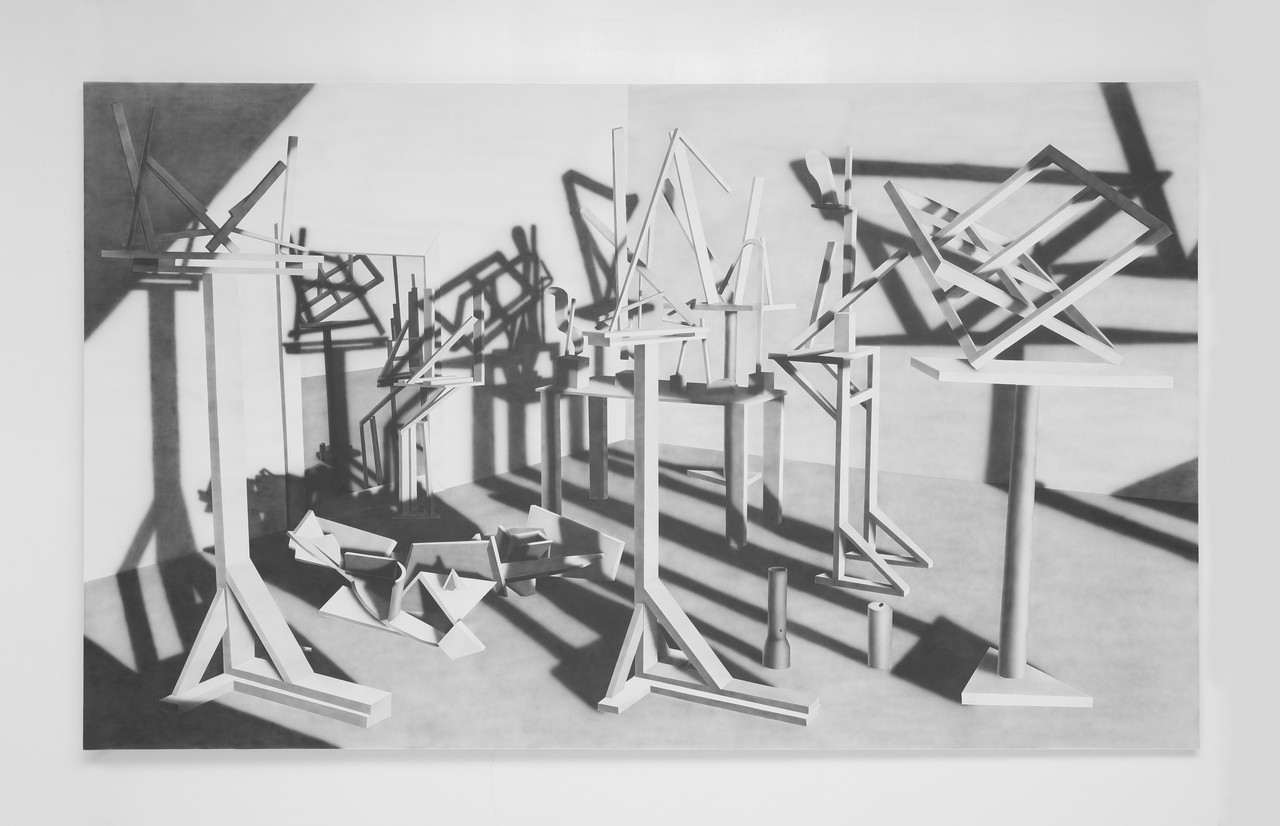
Avery K. Singer, Society of Realist Wanderers (2014). Acrylic on canvas, 120 x 72 in.
This is also present in the work of Smalley, who has gained a facility with digital programs like Photoshop over the years by using it as a tool to make drawings. He prints these out and binds them into books, which he then uses as analog reference points when he makes selections of which to have made into stretched wall works, at which point—in the process of fabrication—they re-enter the digital realm as an image file, before once again being “reborn” into the physical world in yet another guise of a stretched wall work. Smalley does not use canvas, but rather the technique and materials of billboard printing—UV print on vinyl. This is because he sees the work not so much as painting outright, but rather using the focus provided by stretching a material and hanging it on the wall. In the case of his Vector Weave works, what this focus draws our attention to are the curious spatial fluctuations of Smalley’s compositions, which are activated in interesting ways that are different both from how they appear on the computer screen, and in the printouts that Smalley routinely assembles into his work books. If Singer explores how contemporary technology has reified certain longstanding ideas about the logics of spatial experience, then Smalley, another Cooper Union grad who did not study painting, forges into the new spatial territories that digital technology opens up. In a sense, this relates back to the possibilities for investigation opened up by the appropriation of industrial graph papers, which could both, in the hands of an artist like Judd, say, be used to visualize things in traditional ways, which is the lineage Singer continues to update. But, for others, like Smithson, the graph paper becomes a possibility to push the instabilities of isometric projection to an extreme, something Sol LeWitt also explored when, in a way related to Smalley’s process, he decided to fabricate the structural progressions that he first used graph paper to imagine. For the likes of LeWitt and Smalley equally, this perverse application of logic produces an interesting collision and tension between the imaginary and the real.
Darja Bajagić fits in here as well, because she takes her subject matter from the internet but, like Singer, presents it in an "analog" form of (digital) photomontage on canvas. She presents her charged, often pornographic imagery in this way because it introduces a fixity of scale that is absent from the source material which is endlessly manipulable onscreen. This contributes part of our feeling of her figures as having been given back some sense of agency, or at least of identity, in her works. By controlling our gaze in the physicality of the printed canvases tacked the wall, the fact that we must move around them in order to activate the kinds of zooming in and out we could easily accomplish on a screen, as well as the fixed boundaries and the arrest of a narrative that would offer up the woman before us allows a fictive space of both seduction and repulsion. This is contrary to Takashi Murakami’s paintings, which take up, as it were, the screenic logic of an infinitely scalable space seamlessly, such that they collapse a bit too quickly, and totally, the distinctions between screen and canvas.[xiv]
2.jpg)
Darja Bajagić, GroteFoto 5 3 2 Sorry (2014). Mixed Media on Canvas, 20.5 x 24 in.
This shows just how important it is, from a critical standpoint, for artists to work, as Bajagić does, from a space of awkward tension between screen and canvas, rather than simply allowing one to absorb the other. This is something that can also be found in Zak Kitnick’s recent work where images of animals are blown up, ben-day dots and all (resisting the typical logic of scalability, which encourages the retention of visual data by using information dense high resolution files), transposed from taxonomic charts onto individual panels of steel shelving, and arranged in a continuous procession around the gallery. This activates a cinematic experience that is specifically digital in its breaking down of a structurally seamless model—that of the digital video file—into the diluted, dispersed one of the arrayed panels, which the viewer activates into a hallucinogenic flow as he or she scans the gallery.
If there was ever a firm line between abstraction and representation, it is at an all-time low today. The hybridization of painting’s changing set of references has in fact brought painterly work out of a rarified, elitist space, since a set of new meanings and reference points has been introduced that have opened it up to a new, broader audience, one that also has a larger tolerance for abstraction, given their daily interactions with abstractions in the form of icons, backgrounds, etc. on their digital devices. This further charges and endangers the twin problematics of spectacle and dry academicism that have always dogged installation-based work, and which have somewhat strangled, at least for the moment, the possibilities of such an expanded field of painting. Which is not to say that painting cannot interact with architecture and the site of display, far from it, but that it must be highly attuned to its own, newly complex status as an object. Of course, this also suggests an even greater possibility for the reification of painterly work via its deadening entry into the circuits of the commercial art market (a huge, loaded topic which we shall, for the most part, table here). However, it is so as to counter this newly heightened danger that I would suggest many of the younger artists working with painterly means are addressing the distinction between the image status and the object status of the work. It is not enough to insist on one or the other, but rather a rigorous examination must be made of the passage between one state and the other, which of course every work today always occupies, since most are simultaneously in existence as objects and also as jpegs circulating through the internet, in ways intentional and otherwise.
Reception
“Zombie Formalism” has become a trendy, dismissive shorthand for some of the painting I have been discussing. Not acknowledged, however, is that the term “zombie” implies a body, albeit one that is summoned from the crypt, but the fact is that, not only do these artists reject a modernist conception of the work as self-referential to a medium, this rejection is founded in its dispersal. Does a painting lie in the object, or in the image, or in the text about the work? Many artists would answer all of the above, and so with nobody to exhume, that of an undead modernism or otherwise (that has been the job for a self-appointed group of crypt keepers for decades now, artists like Gerhard Richter, Merlin Carpenter, and Michael Krebber)[xv], we are left with something else entirely, a ghost that provocatively haunts art at large? This would give us some insight in the continued obsession with discussing the status of painting, and that this discussion continues to revolve around the tired question of its death and relevance.[xvi]
One example of this haunting aspect is put forth by Ken Okiishi’s recent work, who has addressed art history directly. In a piece recently commissioned by the Ludwig Museum in Cologne, where Okiishi made videos of works in the museum’s collection, the painted marks on top of which mime the form of the original pieces, like stippled dots of paint on a rotating view of a Günther Uecker nail piece. These works introduced a new iteration of this body of work, as Okiishi began to make use of feedback of the image of the painted screen, recording it and introducing it back into the device as its subject. The curious thing is that the image and the object become somehow one and the same, to the point where there is no functional difference—we read the painted dots on the screen as having a similar sense of meaning as the filmic version of Uecker’s nails. Painting here haunts video, both as its subject, but also as the condition that the painted dots force its very technology to occupy.
Parker Ito has, in various bodies of work, explored both of these approaches—of both referencing painting, and dispersing it. In works like his Agony and Ecstasy scotchlite pieces, which are difficult, if not impossible, to photograph as they appear in person, given the odd mutations that result when they are subjected to the camera’s flash, Ito draws our attention to the compulsory nature of the contemporary digital image economy, all in the package of modernist abstraction. In a sense the work can be understood as only being visible when subjected to the photographic, reproductive logic of the camera phone’s flash. Different brands of flash activate the painted surface differently. And yet, of course, once subjected to the flash, the reproducibility of the painting is negated—if its content and subject matter is considered, along conventional lines, to be either its surface or its objecthood. In this way Ito is able to masterfully subvert the modernist insistence on the primacy of a painting’s materiality as well as the more recent imperative for work to circulate freely in jpeg form. Of course an image, of sorts, can be made of the work, but we cannot say that it accurately captures anything about the work. However, because part of the experience of the work is premised on the subjection of the work to the camera flash, nor can we say that it must be seen in person. Somehow the work is about this relay between the object and the image, without there really being much to grasp at either pole of that circulation.[xvii]
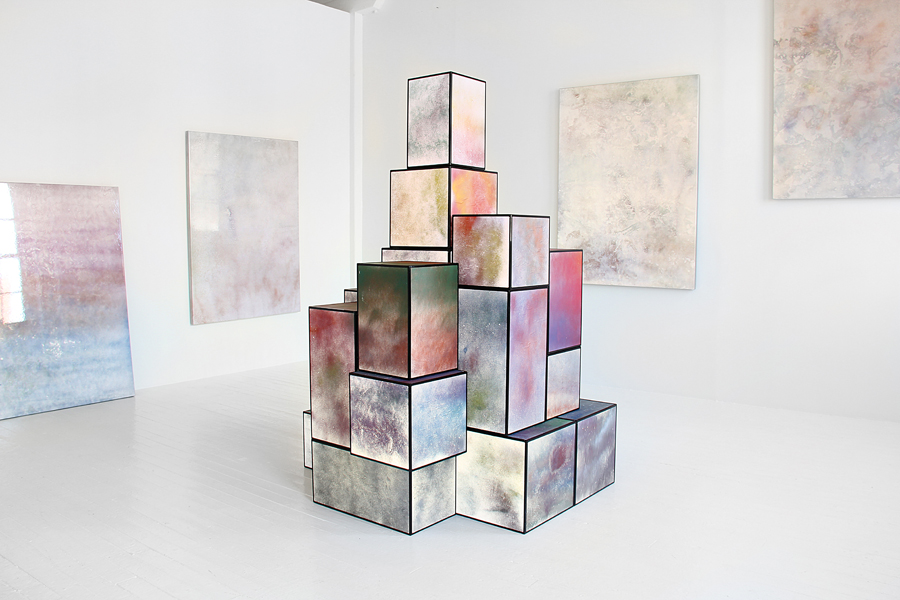
Parker Ito, "The Agony and the Ecstasy" (installation view). Stadium, New York, 2012.
In his interview with Jonathan Openshaw, Staniak nicely sums up this question of the real versus virtual experience of much work today, saying of his own: “Many of my paintings float between flatness and undulation, and this constant shift messes with people’s perception and makes them question what they see in the physical and screen space. […] It is a different experience seeing it in the flesh versus on screen, but one that is just as real in both instances. Real life happens on the Internet and through social media, which is screen-based. I don’t see distinctions between the ‘real’ and the ‘virtual.’ They are just different experiences of the real.”[xviii]
Staniak’s works are deceiving. What at first seems like a flat print is confused from up close, where it becomes evident that the surface is textured. What is grasped in this instant can potentially be stretched out into an infinite temporal experience of the work, involving moving backward and forward to assess these different points of view. This experience becomes even more complex when looking at an image of the same work online, an experience that is not necessary to appreciating the painting, but one which is common, and accepted and even engaged with by the ideas the artist puts forth. Indeed, the complexity of Staniak’s work lies in the matrix of digital image to object. Present as well in more recent work like the Data Loss and stone works, which also play with the complex relationship between image, material, and object. This is very clear when seeing the work in person, where it actually seems more like a flat image at first than when we see it reproduced online. This is probably the result of being used to discerning visual markers of texture in images on the computer, whereas in person, we tend to add in the quality of the object. This leads us to imagine that we are seeing a flat image of a three-dimensional surface. Something that is already resolved on the screen, where objecthood is obviated. Staniak’s paintings thus very effectively demonstrate that today the distinction between the image and the object is not simply blurred or reversed, but rather that they now operate in the same functional reality, and retain a nostalgia for their former ontological separation.
The way the coloristic quality of Jean-Baptiste Bernadet’s Fugue paintings changes with different kinds of illumination, akin to the way laptop and smartphone screens dim and brighten in different light conditions, or how we select different filters on Instagram to bring our images more in line with how we imagine they should look, a quality which could just as easily be fantastical as referential to the actual atmospheric conditions we witnessed. Bernadet’s Fugue paintings are, in line with the musical analogy suggested in their title, about abstract systems of meaning. In this way, despite the superficial formal similarity to Monet’s late water lily paintings, the color field they conjure up is more akin to the way sunspots fill our vision when we glance too close to the sun, or the dance of color across the back of our eyelids on a sunny day. That is to say, they are about some of the most particular and yet ubiquitous optical experiences we might have today, that private space of vision’s breakdown or occlusion, yet where experience and even pleasure persists, and one which cannot (yet) be simulated digitally, despite the fact that today’s most advanced displays are called “retina screens.” This is perhaps one of the last spaces that has not yet been privatized and instrumentalized, yet can still be evoked by a painting, and which is thus shared, because physiological, but not public, for it cannot be photographed, uploaded, or downloaded. It is thus an experience that is still the viewer’s own property.
Jacob Kassay’s silver paintings, which are canvases coated in acrylic that the artist sends to be commercially plated with silver, are about our expectations of how vision operates—what we see, and our engagement with our own image. People talk about how they absorb their surroundings, but of course they are not mirrors, they are plated silver. You have to burnish the silver to make it reflective and Kassay doesn’t do that, he just takes them as they’re made in the plating process, which gives them very interesting surfaces. Up close the reflection is hazy, but as you go back it gets clearer, and if someone walks by you see them very clearly, while they see themselves as a blur. They are a very concrete commentary on a certain type of perception. These paintings are a suggestion about the fragmentary and contingent nature of vision and, insofar as this relates to our forging of identity through the endless stream of images we seamlessly upload and download, they have a contemporary valence. This is embedded in the functioning of Kassay’s surfaces, which solicit our desire to see ourselves, which has found the apogee of its contemporary expression in the obsession with taking and sharing of selfies. Indeed, people love to try to take their picture as it appears in a Kassay painting, but they find that their individuality is all but melted by the distortions of the plated metal. We expect for the Kassay to mirror us back, but instead we are faced with a caesura of vision, a literal blurring out. A Kassay painting is a construction of a complex visual system, because a viewer wants to move around them to resolve the image, but it’s impossible. Nor can the autofocus of a camera map one of these paintings, which is radical considering the sinister potential of technologized forms of spatial mapping and image profiling. The work is not “about” that technology, but it nonetheless speaks to it obliquely. Kassay has recently continued this investigation of fragmented vision more literally in the form of shaped canvases made by stretching, as is, the cast off excess fabric shed during the making of his and other artists’ work.
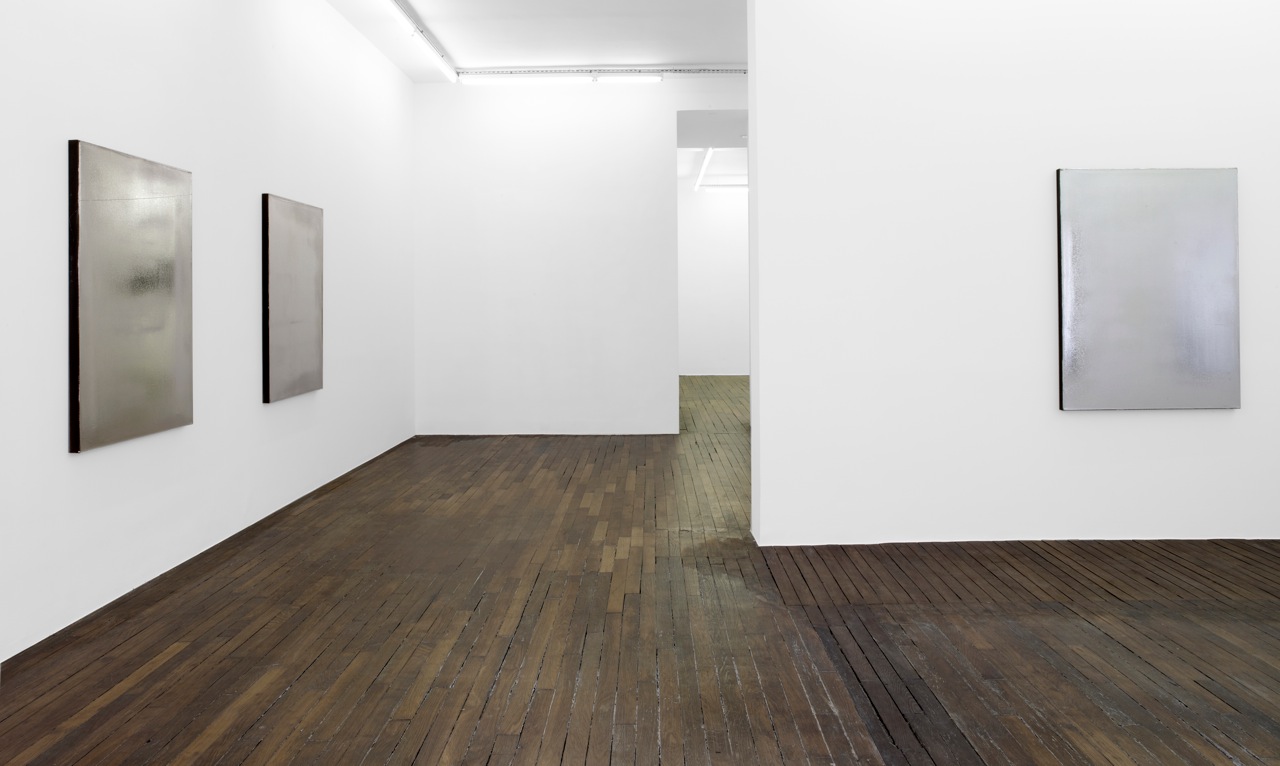
Exhibition view, Jacob Kassay, Art:Concept, Paris, May 8th to June 5th 2010.
Thus we discover the political aspect shared across the very different work of artists as varied as Okiishi, Singer, Ito, Kassay, Staniak, and Bajagić. Whether they use an abstract language of gestural marks or monochrome surfaces, or else infinitely scalable images, these artists make productive use of painting’s ability to arrest and reanimate image and object alike. Paintings today, while, thanks to their proximity to digital devices, are able to occupy some of the spectatorial conditions of these devices, still function differently from them due to their relative stasis and fixity, which means that, as undead zombies haunting the spaces of technology show how the ways we view and consume images and objects alike today might happen differently, and not by harkening back to an imagined pre-industrial past, but by refashioning looking in the present, and with an eye to the future.
[i]. Michael Staniak in Jonathan Openshaw, “Painting Across Platforms.” Postmatter.com. September 5, 2014.
[ii]. For a tentative attempt to discuss this aspect of painting’s dispersal see my presentation as part of the Rhizome organized panel “Brushes.” The New Museum, New York. September 3, 2015.
[iii]. Clement Greenberg, “After Abstract Expressionism” (1962), Collected Essays vol. 4, ed. John O’Brian (Chicago: University of Chicago, 1993), 131 – 132. My citation of Greenberg is meant to show exactly how far removed we are from his discourse of Modernist painting, which most painters working today consider as historical fact rather than as present dogma, if they consider it at all. The continued assumption that all appearances of abstract painting fit into his schema is simplistic yet common. It relies on a baffling, yet regularly repeated misreading of Greenberg as a materialist interested in the physical terms of painting—the stretcher, canvas, paint, etc. When he was only interested in such things insofar as they motivated his notion of painting’s orientation towards its inherent two-dimensionality, or flatness, which for him opened painterly work onto optical effects, which precisely dematerialize the work. His inability to accept the work of Frank Stella is just the first indication of how anathema he was to many of the traditions of abstract painting. For just one of the most recent such misreading, see Lilly Lampe’s “ ‘Painter-painter,’ and the Lingering Specter of Greenberg,” Brooklyn Rail (February 2016). For a careful scholarly analysis of the ramifications of Greenberg’s discourse on painting vis-à-vis Minimalism and Conceptual Art, see Thierry de Duve, “The Monochrome and the Blank Canvas,” in Serge Guilbaut, ed. Reconstructing Modernism: Art in New York, Paris, and Montreal, 1945-1964 (Cambridge, MA: The MIT Press, 1990), 244-310.
[iv]. Leo Steinberg, “Other Criteria,” Artforum (March 1972). Reprinted in Steinberg, Other Criteria: Confrontations with Twentieth-Century Art (London: Oxford University Press, 1972), 84.
[v]. Steinberg, “Other Criteria,” 84.
[vi]. Hal Foster, “Signs Taken for Wonders,” Art in America (June 1986): 88.
[vii]. Staniak, Statement for Permanent Display. Exhibition. Annaruma Gallery, Naples. March, 2015.
[viii]. Richard Shiff, “Optics,” New York Painting (Bonn: Kunstmuseum Bonn, 2015), 41-52. As mentioned in note 3, one example of this limited toolbox is the continued reliance on Clement Greenberg as the only key to unpacking the terms of abstract painting. An example of this critical failure to see beyond Greenberg and the modernist paradigm he established in evaluating contemporary artistic production is David Geers’s shortsighted dismissal and suspicion of anything resembling modernist tropes in his “Neo Modern,” October 139 (Winter 2012): 9-14.
[ix]. Robert Mangold, “Flat Art” (1967). First published in Nancy Princenthal, ed. Robert Mangold (New York: Phaidon, 2000).
[x]. This is an issue with its own longer history, given that it was introduced as early as Picasso and Braque’s use of sand and collage in their painting surfaces, and then extended through Schwitters’ Merz reliefs, on to Jackson Pollock and Frank Stella’s use of industrial enamels and metallic paints, up to Peter Halley’s highly variegated neon surfaces and Olivier Mosset’s use of truck bed paints, to suggest just a brief and highly selective genealogy.
[xi]. Donald Judd, “Specific Objects.” Arts Yearbook (1965). Reprinted in Judd, Complete Writings, 1959-1975. (New York: New York University Press, 1975), 187.
[xii]. It is no surprise, then, that Charles and Ray Eames’s well-known film, Powers of Ten (1977) is a touchstone for Smalley. Not so much for the wonder it expresses in the act of traveling from the atom to the universe, and back again, but because of its prescience at diagnosing our desire to interact with all images in such a fashion.
[xiii]. Avery Singer in “Unrealized, or The Realm of Thought: Avery Singer Interviewed by Lauren Cornell,” Mousse 39 (May 2013): 175.
[xiv]. Pamela Lee examines this situation in her astute analysis of Murakami’s work: “Economies of Scale,” Artforum (October 2007): 336-343.
[xv]. See for example the over two decades old debate between Robert Storr and Yve-Alain Bois about Robert Ryman as “crypt keeper of Modernism.” Certainly we would not call Ryman a zombie formalist, at least along the lines established in contemporary criticism, but this debate is just one example of how flimsy the term is, from both an intellectual perspective, and based on how poorly informed it is regarding art history.
Bois refers to Ryman, vis-à-vis the Austrian writer Karl Kraus as, in relation to modernism, “in the same position that Kraus occupies in relation to the German language: standing guard at its tomb.” This caused Storr to critique Bois as a grave-digger of painting. See Bois, “Ryman’s Tact,” October 19 (Winter 1981): 102-103. Storr, “Simple Gifts,” Robert Ryman (New York: Museum of Modern Art, 1993), 45n74. Bois responds to Storr in a pithy corrective footnote in his “Marden’s Doubt,” Brice Marden: Paintings 1985-1993 (Bern: Kunsthalle Bern, 1993), 65n59
[xvi]. This conversation should have been definitively quashed long ago by Bois’s seminal, “Painting: The Task of Mourning,” in David Joselit, ed. Endgame—Reference and Simulation in Recent Painting and Sculpture (Boston: Institute of Contemporary Art, Boston, 1986). Reprinted in Bois, Painting as Model (Cambridge, MA: MIT Press, 1990).
[xvii]. More recently, in a “turn” to imagery, Ito has—in way a parallel to Singer—used the digital for his source material, like her resulting in a conversation between art historical representational tropes and the "non-“ or “extra-artistic" ones of digital imagery and its online databases.
[xviii]. Staniak in Openshaw, “Painting Across Platforms.”
